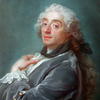More about Madame de Pompadour
- All
- Info
- Shop

Sr. Contributor
Madame de Pompadour was the original celebrity brand, setting trends across centuries from Elvis Presley’s pompadour hairdo, to a collection of china in pompadour pink by artist Cindy Sherman.
Her perfect lips allegedly inspired the marquise cut diamond, and her rounded breasts the champagne coupe (an honor shared with Marie Antoinette, and just as dubious in both cases).
Pompadour exchanges her signature pink for a pale peach gown in this portrait by Boucher, but she would be the first to agree with Legally Blonde’s Elle Woods that “Whoever said orange was the new pink was seriously disturbed.” After all, she brought pink into style as the new color of luxury. Yet, Pompadour was more than just a rococo/rockabilly style icon.
Jeanne Antoinette Poisson was born to an obscure, bourgeois family, but a fortune teller predicted she would win the heart of a king. Her mother and a wealthy benefactor (probably her biological father) nicknamed her “Reinette” (little queen), and started grooming her to become chief mistress of Louis XV.
The first step to the King’s bedchamber was marrying an innocent, well-connected dupe. Unlucky bachelor number 1 was Charles Guillaume le Normant d’Etiolles. They had two children, both of whom died in childhood. Her status as a wealthy society wife allowed Jeanne, now Madame d’Etiolles, to set up a Paris salon, where she matched wits with such Enlightenment philosophers as Voltaire. Her husband also came with the advantage of an estate near the King’s hunting lodge.
Always keen to make a fashion statement, Jeanne contrived to catch Louis’ Attention, first by riding in front of his hunting party, first in a blue carriage dressed in a pink gown, then in a pink carriage dressed in a blue gown. This stunt got her invited to a masqued ball at Versailles. Jeanne appropriately appeared as Diana, mistress of the hunt, while Louis was part of an eight-man costume ensemble resembling an avenue of topiary trees. The court gossips noted that Madame d’Etiolles’ coach was parked outside the King’s apartments the next morning, suggesting she had stayed the night.
Louis granted poor hubby Charles a noble title and promptly sent him packing, leaving Jeanne available as the newly styled Marquise de Pompadour. Charles had committed the horrible faux pas of falling in love with his own wife, and fainted when he learned the news that she had ditched him. Don’t grieve for him too much, though; a pretty opera girl helped to dry his cuckold’s tears. Ah, the French!
As royal mistress-in-chief, Pompadour was no high class hooker, but the most influential stateswoman of eighteenth-century France, effectively serving as the King’s prime minister. Critics blame her for the restructuring of alliances that caused the Seven Years War, a humiliating military disaster which bankrupted France and lost the Canadian colonies. Perhaps sending battle maps to generals with her cosmetic beauty spots marking strategic positions was a bit too distracting. On the other hand, admirers praise her patronage of philosophy and the arts, which established France as the cultural capital of the Western world. Indeed, she was an accomplished artist and academic in her own right, with a portfolio of engravings and a library of 3,525 books.
Ironically, one area in which Pompadour was not as prolific was in the bedroom. Though the King came to her boudoir 9 times a day early in their relationship, she regarded herself as a frigid lover, and poor health and reproductive issues made her incapable of intercourse by age 29. Nonetheless, Louis kept her on as his most trusted adviser, proving it was her intellect, not her body, that attracted him. Rumors persist that she pimped out young virgins, or even arranged orgies to satisfy him sexually. More likely, she merely tolerated his affairs with other women. It was a lesson she had learned from the King’s own wife, Queen Marie Leszczynska, who liked Pompadour and reportedly said of her, “If there must be a mistress, better her than any other.”
Despite Boucher’s numerous, vivid portraits of Pompadour, her brother claimed the artist never captured her likeness. This is Boucher’s last in the series, and reflects her shifting position at court from lover to platonic friend of Louis XV. The classical statue in the background is an allegory for Friendship consoling Love, evoking a real-life sculpture Pompadour had commissioned by Jean-Baptiste Pigalle. Love is obviously the amorous King, and Friendship the former mistress. Her favorite spaniel also makes an appearance, representing loyalty. In other words, the sexy times are over, but we can still be friends.
Madame de Pompadour died of tuberculosis just a few years after this was painted. The King deeply mourned her, remarking as rain fell on her departing coffin, “The Marquise won’t have good weather for her journey.” A quietly touching farewell to the woman who had been his great love, and even greater friend.
Sources
- Archer, Sarah. “A Western Cultural History of Pink, from Madame de Pompadour to Pussy Hats.” Hyperallergic, February 20, 2017. https://hyperallergic.com/359159/a-western-cultural-history-of-pink-fro…
- Aron, Sue. “Madame de Pompadour: The Uncrowned Queen of France.” Bonjour Paris, December 22, 2016. https://bonjourparis.com/history/madame-de-pompadour/
- Biography.com. “Madamde de Pompadour.” Accessed June 15, 2017. https://www.biography.com/people/madame-de-pompadour-21075947
- Bluehost. https://ifitshipitshere.blogspot.com/2008/06/cindy-shermans-madame-pomp…
- McDowall, Carolyn. “Jeanne Antoinette Marquise De Pompadour - Woman of Influence.” The Culture Concept Circle, March 7, 2014. https://www.thecultureconcept.com/jeanne-antoinette-marquise-de-pompado…
- McNeill, Maggie. “Madame de Pompadour.” The Honest Courtesan, December 29, 2010. https://maggiemcneill.wordpress.com/2010/12/29/madame-de-pompadour/
- Stamberg, Susan. “More Than A Mistress: Madame De Pompadour Was A Minister Of The Arts.” NPR, May 10, 2016. http://www.npr.org/2016/05/10/477369874/more-than-a-mistress-madame-de-…
- Thurman, Judith. “Eminence Rose: Wallowing in new biographies of Madame de Pompadour.” The New Yorker, October 7, 2002. http://www.newyorker.com/magazine/2002/10/07/eminence-rose
- Wallace Collection, The. “François Boucher (1703-1770), Madame de Pompadour.” Accessed June 15, 2017. http://wallacelive.wallacecollection.org/eMuseumPlus?service=ExternalIn…













